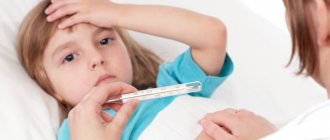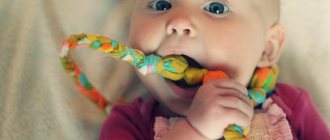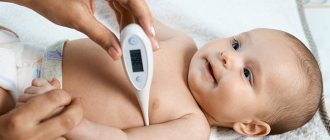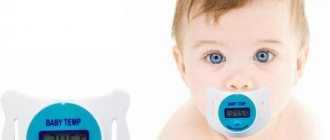Quick transition : fever, cough-runny nose, does not roll over, is capricious, has bad stools, eats poorly, frequently spits up, sneezes, teething, arches, sticks out tongue, sleeps poorly, does not laugh, acne, sweats a lot, squints eyes.
Your baby can now kick and wave his arms. He learned many independent actions, but at the same time, the possible problems that could await him in the fourth month of his life increased. Let's try to find out in more detail about what problems a baby may have when returning so early.
Temperature
If a child has a fever at 4 months, then before panicking, it is necessary to take into account a number of factors. First of all, in children at 4 months the normal temperature is 37 degrees, and for children over 6 months – 36.6. Secondly, the time of day when you will measure it. The highest temperature is in the evening, and the lowest in the morning. Thirdly, the physical condition of the baby. After active games the indicator will increase, and after rest it will decrease.
Some babies have a normal temperature, the level of which is slightly lower or higher than the statistical average of 36.6. If a child has a low temperature, then in most cases this indicates overwork, malnutrition or the presence of a number of diseases. However, most often parents have to deal with the increased. This is considered one of the main signs of an intestinal infection, influenza, bronchitis or ARVI. In addition, a high temperature can be a sign of stress or overwork.
Possible reasons
If there are no obvious symptoms of a cold, the reasons why a child has a fever without cold symptoms may be as follows:
Teething reaction
The child's body can react to teething by raising the temperature above 38 degrees. In this case, additional symptoms will be restless, interrupted sleep, excessive drooling, swollen gums and the desire to bite hard objects.
Transient fever
If the child is no more than a week old and the temperature is above 38, his condition can be explained by adaptation to environmental conditions in such a way as an elevated temperature that lasts one or two days. This condition is called "transient fever". The first day is the most important; such fever in very rare cases lasts more than one day.
Overheating of the body
A one-year-old child may develop a temperature of 38 degrees from being in warm clothes in a very heated room. The baby's body is not yet accustomed to adapting to environmental conditions due to the lack of its own thermoregulation. A child can overheat from fast running and active games, so it is better to allow them to wear light clothing.
Manifestations of allergies upon contact with irritants can cause not only a rash and runny nose, but also the manifestation of an elevated temperature in a child, up to 5 days without symptoms.
Reaction to vaccinations
Fever may occur as a result of vaccination. A temperature of 38 in a child may well be a reaction in response to the introduction of a vaccine. If the high temperature level persists for more than 2 days, you should consult a doctor.
Urinary tract infections
Very often, the only symptom of urinary tract infections in children is an increase in temperature to 38. If this infection is suspected, it is necessary to take a urine test.
Against the background of complete well-being, the temperature suddenly rises. The readings on the thermometer are quite frightening: 38 - 40°C. At the same time, deterioration in well-being does not always occur, and if it does, it is often insignificant. The fever is not accompanied by a runny nose, cough, headache or vomiting with diarrhea. From the second day, the child may experience some apathy and lethargy, but this is also not a necessary sign. The condition at high temperatures is quite satisfactory. This may be due to an infection caused by the herpes virus. The fever lasts an average of 3 days (another name for roseola is three-day fever). The temperature does not respond well to antipyretics and does not fall below 38°C.
Incubation period of other viral and bacterial infections
The incubation period of a number of bacterial infections (for example, otitis media) or viral infections (for example, ARVI) rarely appear without additional symptoms, but such cases are possible. If a child has a temperature of 38 for 2 days, even if the child does not show concern, he must be shown to a doctor.
Cough, Runny nose
If a child has snot at 4 months, then the first thing you should know is that you should not treat it with all the methods known to you. Remember that even the best recommendations are only good if they can help in a specific specific case. Under no circumstances should you experiment on your baby’s health with various “grandmother’s medicines”; you don’t want your baby to feel worse, do you? A runny nose at 4 months can be caused by colds, an allergic reaction, or when teeth are thinning.
If you notice a cough in a child at 4 months, then first of all it is recommended to monitor the general condition of the baby and the course of the disease. If your health condition worsens, it is recommended, without hesitation, to call a doctor who will not only determine the true cause of its occurrence, but also prescribe correct and effective treatment. By the way, treatment may differ depending on the type of cough, because it can be either dry and persistent, or wet with the discharge of mucus and sputum. So, for example, if there is mucus in the lungs and a dry cough, the doctor may prescribe drugs - mucolytics, which are designed to speed up the passage of mucus from the lungs. In such situations, vibration massage of the chest is often necessary. If the cough is unproductive (without sputum) and dry, then it will be more effective to use medications aimed at suppressing the cough.
Causes of hyperthermia
Under normal conditions, body temperature should not exceed 36.6 degrees. Even a slight increase in this indicator can signal pathologies in the body.
An increase to 38 degrees or more indicates that the immune system has begun an active fight against pathogenic bacteria or viruses.
Essentially, hyperthermia is a protective reaction of the body that helps it cope with pathogens. Changing the temperature regime helps suppress the infection, as a result of which the immune system is able to cope with the disease faster.
But in some cases the mechanism fails. If a child has a fever for more than 4-5 days in a row, this can provoke irreversible changes in the brain, which is simply not able to function normally during a fever. Impaired thermoregulation of the body in some cases leads to death, so if a problem is detected, you should immediately seek help from a doctor.
It is worth noting that fever does not always indicate the development of infectious diseases. Temperatures up to 38 inclusive can be caused by:
- overheating, heat stroke, nervous overexcitation, urinary tract infections, teething in children under 1 year of age, childhood infections (measles, chickenpox, scarlet fever), brain infections (meningitis, encephalitis), insect bites, taking medications.
If the threshold of 38 degrees is passed, the cause should be sought in the following diseases:
- otitis and ARVI; flu and sore throat; bronchitis and mononucleosis; gastroenteritis and diarrhea; endocrine pathologies, reaction to vaccination (vaccination against measles, influenza, whooping cough).
Doesn't turn over
You shouldn't worry too much if your baby doesn't roll over at 4 months. Each child requires an individual approach, and in this case there are no clear age limits. But the child is guaranteed not to get worse from special developmental activities, so an important task for parents is his development. What exercises should be done to develop this skill? It is best to do things with your baby that he likes in order to attract attention. For example, you can remove his favorite toy from the pendant and put it on the side. To see where she disappeared, the child will begin to roll over on his side, making movements with his legs and arms. It often happens that the baby turns over only in one direction. In this case, you should also perform the exercise, but place the toy in the direction in which the baby does not want to roll over. If a child does not roll over at 4 months, the muscles of his legs and arms may also be underdeveloped.
Is being capricious
A child of 4 months may be capricious in response to the desire to satisfy his desires, which were initially denied to him. Another reason may be resistance to the need to carry out the will of the parents. You can distinguish the causes of a baby’s whims depending on their origin, as well as the development of his psyche and age. Factors that encourage whims at such an early age may be the following:
- lack of attention;
- anxiety and fear;
- tension and anxiety;
- desire to sleep;
- feeling hungry or thirsty;
- desire to have fun or play;
- feeling hot or cold;
- discomfort from uncomfortable clothing or shoes, diaper or other accessory;
- painful condition or lack of energy and strength.
It is at this age that parents begin to succumb as much as possible to the whims of the baby; this happens because they do not know how to calm their child differently. But the danger of this situation is that such concessions lead to the fact that every time the baby will get his way in exactly this way, and over time this will turn into a trait of his character.
Bad stool
Poor bowel movements in a 4-month-old child can occur as a result of viral or bacterial infections, or as a complication following antibiotic treatment. There is also a chronic presence of diarrhea, in which case loose stools occur more than three times a day, and this situation continues for three weeks. In cases where diarrhea is the primary symptom of dysentery, it is very important to provide immediate assistance to the baby.
Functional diarrhea can also be distinguished if the general condition of the baby was not disturbed during diarrhea, and there are also no disturbances in its physical development (normal weight gain, height). In the event of a bowel disorder, it is very important to be extremely attentive to the baby’s well-being and promptly inform your pediatrician about this, because in a baby at this age, diarrhea can lead to dehydration.
Choice of antipyretic drugs
Approved drugs
Paracetamol- based drugs are used worldwide as effective and safe antipyretic drugs for fever in children.
and
Ibuprofen.
Important: the calculation of the volume of antipyretic drugs must be calculated based on the weight of the child, and not just the age of the child.
The drug of first choice is Paracetamol
(Acetaminophen, Tylenol, Panadol, Prohodol, Calpol, Efferalgan, etc.) in a single dose - 10-15 mg/per 1 kg of weight (no more than 3-4 times a day).
It has only a central antipyretic and moderate analgesic effect, does not affect the blood coagulation system and, unlike ibuprofen, does not cause unwanted reactions from the stomach. Of the dosage forms of Paracetamol
in children, preference is given to soluble forms: syrups, effervescent powders and tablets for preparing solutions, the effect of which occurs within 30-60 minutes and lasts 2-4 hours. Paracetamol in suppositories has a longer effect, but its effect occurs later and a single dose is up to 20 mg/per 1 kg of weight.
Ibuprofen
- a drug from the group of non-steroidal anti-inflammatory drugs, has, in addition to the central, peripheral anti-inflammatory effect; it is used in a single dose of 6-10 mg/kg (no more than 3 times a day). Ibuprofen is recommended as a second-choice antipyretic in the following situations:
- for infections with a pronounced inflammatory component (otitis media, sinusitis, pneumonia) in cases where fever in children is accompanied by pain reactions (headache, muscle pain, ear pain, teething pain, etc.)
Ibuprofen is available for children in the form of syrups “Ibufen”, “Nurofen”; The use of tablet forms is possible in children over 12 years of age.
Important points when using antipyretic drugs:
When choosing antipyretic drugs to relieve fever, you must always remember to comply with the dosage of the medications used. Carefully read the instructions included with the drug. The dose of the drug depends on weight and age. Thus, in children in the first three months of life, both drugs are used in smaller doses and with a smaller frequency of administration; In case of “White fever”, taking antipyretic drugs should be combined with rubbing the child’s limbs to reduce vascular spasm. As prescribed by a doctor, in this case, antispasmodics can be prescribed to relieve vasospasm, since antipyretic drugs may not be effective enough; You should not use antipyretics for more than 3 days unless prescribed by your doctor; If possible, you should avoid using an antipyretic drug in a child receiving an antibiotic, as this makes it difficult to assess the effectiveness of this therapy.
Important: Antipyretics should not be prescribed as a “course” in order to prevent fever: taking antipyretics more than 3-4 times a day is unacceptable due to the risk of missing the development of a bacterial infection.
Antipyretics that are not recommended for use in children
, Amidopyrine, antipyrine, and phenacetin have been excluded from the list of acceptable antipyretic drugs
Acetylsalicylic acid (aspirin)
in children with ARVI, influenza, chickenpox, it can cause Reye's syndrome - a severe encephalopathy with liver failure and a mortality rate above 50%. This served as the basis for banning the use of acetylsalicylic acid in children under 15 years of age with acute viral diseases.
Metamizole (analgin)
- can cause anaphylactic shock, as well as agranulocytosis with a fatal outcome. Another undesirable reaction to this drug is a prolonged collaptoid state with hypothermia (34.5 0 - 35 ° C). All this was the reason for its ban or strict restriction of use in many countries around the world. The use of analgin is possible only for intramuscular administration (50% analgin solution, 0.1 ml/year of life) in exceptional cases to reduce temperature during emergency care.
Nimesulide should not be used as an antipyretic in children.
due to its proven nephro- and hepatotoxicity.
Doesn't eat well
If a child at 4 months does not feed well at the breast, then the reason for this refusal may be the unpleasant taste of mother's milk. This change can occur under the influence of smoking, as well as consumption of alcoholic beverages or foods that have a specific smell and taste such as herring, garlic, onions, seasonings, spicy dishes, and so on.
Often those children whose daily routine is not followed or established do not eat well. To prevent this from happening, it is necessary to set the exact feeding time and give the child food every day strictly according to the clock. A breastfed baby at 4 months usually develops a certain routine. Some periods of decreased appetite may occur during illness or when new foods are introduced. Often, at 4 months, the baby’s gums begin to bother him, which can also worsen his appetite. In addition, throughout the day the baby may experience a period of lethargy when he eats without pleasure.
Spits up often
It is at 4 months that a child spits up most often. During this period, the baby begins to actively move and try to roll over onto his tummy, which is precisely what is a common cause of regurgitation. Is it necessary to do something about this? No, since this is not a disease, but a physiological norm typical for children under 6-8 months. Often, children who spit up profusely are prescribed special milk formulas, which contain a gum thickener (carob gluten, also called Mediterranean acacia) in varying concentrations, for better absorption of food and prevention in general. The mixture begins to curdle the contents of the stomach, and the child is unable to regurgitate food, as the concentration becomes unbearable and viscous. This contributes to an increase in the load on the small tummy, especially on the pancreas, which in the future can negatively affect the general condition of the child and change the metabolic rate. It should also be said in fairness that in some cases it is still necessary to treat excessive regurgitation. If your baby is not active, looks sick, doesn’t gain weight well, pees little and spits up a lot, then this is a serious reason to visit a doctor (necessarily a neurologist and pediatrician).
Sneezes
Why does a 4 month old baby sneeze? In some cases, this may be due to very dry air in the room. Sneezing helps clear the baby's nose of dry particles and dust. This phenomenon is called “physiological runny nose.” For inexperienced parents, the birth of a baby is in most cases accompanied by a lot of anxiety and worry. Every movement of the child causes anxiety - is everything okay with the child? And if the baby coughs, sneezes or groans, then a diagnosis is immediately made - the baby is sick.
It is necessary to immediately decide that not every tiny sneeze should be elevated to the “rank” of a disease. After all, a baby who is only 4 months old already has the same reflexes as an adult, and may well sneeze “just like that.” Therefore, if a baby sneezes, it is quite possible that he is simply clearing his nose of dust that has fallen into it.
How to choose an antipyretic drug
In case of a sharp increase in the temperature of a baby, it is necessary to have medications at home to reduce it. Parents should be aware that paracetamol-based medications (such as Panadol) are best for children. Preparations based on analgin and aspirin are contraindicated for children, and are also not recommended for adults in most countries of the world. In order not to torment your baby by forcing him to swallow a pill, buy paracetamol in the form of syrup or rectal suppositories - this is much more convenient. Do not mix the crushed tablet into food or drink! Always strictly adhere to the dosage calculated based on the patient’s age and weight. If the drug does not help reduce the fever, do not exceed the dose, but call an ambulance.
Teeth cutting
At 4 months, a child begins to cut teeth; this can be recognized by frequent crying at night and increased salivation. How can one alleviate his suffering? Let him chew crackers, dry bread or bagels, this will allow his teeth to “break through” the gums faster. In some cases, parents do not see the edges of the incisors; it may seem that the baby’s gums are not even swollen, but he continues to cry and cry. And what to do in such a situation? You shouldn't trust your eyes. Touch your gums with the pad of your index finger, or lightly tap them with a teaspoon. You will be able to feel the hard edge of the tooth with your hand, and the spoon will make a hard sound. In this case, all your doubts will be dispelled. If the baby’s fever persists for 24 hours, loose stools or a runny nose develop, then such troubles are most likely also associated with teething. You should not feed your child Calpol; it is better to call a pediatrician at home.
Arches
Why does a 4 month old baby arch? Let's look at the main reasons:
- colic. The child arches, cries and throws back his head. Such symptoms may indicate simple infant colic, which often bothers children at this age. The baby's crying is long and very intense - colic can continue for more than three hours in a row - this fact is well known to pediatricians, so do not rush to sound the alarm, after the fourth month everything should go away;
- improper feeding. If the baby arches and cries when feeding, this may mean overindulgence (he is full, but does not want to give up his mother’s beloved breast), and he may also be unhappy with something during the feeding process (for example, the milk has an unusual taste or there is too much of it) ;
- nasal congestion. Arching can occur as a result of difficulty breathing, and is accompanied by a characteristic “grunting” sound. Check if your baby can breathe easily. If there are breathing problems, wet clean the room and rinse the baby’s nose with a saline solution;
- neurological problems. If the baby arches strongly in his sleep, this may be either his individual characteristic or indicate the presence of hyperactivity, increased intracranial pressure or increased tone. Make sure that your baby's day is calm and follows a certain routine.
37.4 lasts more than a week
If the readings change from time to time, this is either measurement errors or evidence of overheating. You should monitor the baby and record his changes in behavior and condition. If it is active, then no treatment is needed. When low-grade fever persists for more than a week, there is no need to rush into taking antipyretics.
Proceed as follows:
- Find out what is bothering the baby: runny nose, cough, pain.
- Be sure to follow a drinking regime. As the temperature rises, the water-salt balance is disrupted and dehydration occurs. Put your baby to your breast more often, give him some water to drink from a bottle - that’s all you need. Older children can be offered cranberry juice or dried fruit compote.
- If the condition worsens, wheezing, convulsions appear, vomiting occurs, breathing is difficult, and the temperature begins to rise even after taking medications, be sure to call an ambulance.
- A certain microclimate should be created in the children's room - 21-22 degrees Celsius, moderate humidity. If the air is dry, complications may occur: bronchitis, otitis media, pneumonia.
- If the baby is not cold or shivering, then dress him in light clothes made from natural fabrics: rompers, a cotton shirt or blouse are ideal. When the baby is sleeping, cover him with a fleece blanket or flannel diaper.
Additional Information. After vaccination, the increase in temperature is not accidental - this is how the body fights and produces antibodies to the injected pathogen. Giving an antipyretic should be considered carefully, since the vaccine sometimes causes hypothermia, and Ibuprofen or Paracetamol only worsens the situation.
If subfebrile values persist for a long period, this may indicate the presence of anemia, helminthic infestation, and brain diseases. A thorough medical examination will provide an accurate diagnosis. If no problems are identified, you should definitely start strengthening the baby’s immunity: start to harden yourself, take regular walks, regulate your diet, sleep and wakefulness.
Sticks out tongue
If a child sticks out his tongue at 4 months, this may mean the following:
- baby is hot. The baby may stick out his tongue because he is simply hot. In this case, two mechanisms are triggered: the child increases the surface of the body from which liquid evaporates, thereby triggering the body cooling mechanism, and at the same time asks for a drink;
- the child “sharpenes” his gums. When the baby begins to teethe, he experiences a rather strong unpleasant sensation and receives strong relief if he manages to “scratch” them. Various teethers, your own hands, toys, diapers, and in some cases, your tongue are used;
- The child has problems in the oral cavity. In some cases, a child develops painful ulcers on the oral mucosa - stomatitis (thrush). Whenever they are touched, the child begins to experience pain. Therefore, he can stick out his tongue in order to reduce the intensity of painful sensations;
- The child has a pathology of the nervous system. During childbirth, the baby's cervical spine suffered high loads. In some babies, this later manifests itself with a variety of symptoms, one of which may be protruding tongue;
- The baby has hypothyroidism. This is perhaps the most dangerous cause of tongue protrusion. Late diagnosis of hypothyroidism can lead to serious consequences: the child begins to lag far behind his peers in mental development, up to complete cretinism.
Doesn't sleep well
What to do if a 4 month old baby doesn’t sleep well? The problem of poor sleep especially concerns the daytime. However, it is necessary to remember that every child has biorhythms and each one has their own. Some babies sleep little during the day, but sleep a lot at night. Others are full of energy and strength in the evening, and it is extremely problematic to put them to bed at 21.00. If a child sleeps at the appropriate time according to his age, then there is no reason to worry and change his schedule. There are times when the baby sleeps very poorly at night and often wakes up, in which case the reasons for poor sleep may be the following:
- the children's room is very stuffy and hot (the air temperature in the room should not exceed +24 degrees);
- the child is hungry;
- after taking a hot bath, the child is overexcited (let the water temperature not exceed +37 degrees during bathing);
- overexcited before bedtime (experiences a storm of emotions);
- allergic itching;
- worms or intestinal disorders;
- runny nose.
How and with what to treat a child with a temperature of 38?
Call a doctor immediately. Do not lower your temperature to 38.5 degrees with medications. Eliminate sound and light stimuli in the room. If the baby is breastfed, put him to the breast or give him expressed milk - a source of immunoglobulin and antibodies. If there is an appetite, feed your baby easily digestible foods (for example, vegetable or fruit purees). Provide plenty of fluids. Fever provokes dehydration, which can lead to even greater disturbances in the body’s thermoregulation. Mineral water without carbon and sweeteners, as well as chamomile tea, will help cope with the problem. Make a wrap. Cotton cloth should be moistened in plain water and wrapped around the child’s body. Never apply ice to your forehead or do enemas with cool water. It is also not recommended to do vinegar or vodka rubdowns, as they dry out the skin. Try to maintain the temperature in the room no more than 21 degrees. Due to heat exchange with the environment, body temperature should decrease by 1-2 degrees. If moderate hyperthermia is observed (38.5-39 degrees), antipyretics can be used to combat it.
Some of the most effective and safe antipyretic drugs for children include:
- Paracetamol. Also included in Efferalgan and Panadol. Analgin. It has a pronounced antipyretic effect, so it can be used for high hyperthermia. In critical situations, the medicine is best administered intramuscularly to achieve a rapid reduction in temperature. Also included in Pentalgin and Baralgin. Ibuprofen . It has not only antipyretic, but also analgesic effects. It is used to combat infections accompanied by inflammatory processes in the ENT organs.
Before treating a child with the above medications, it is advisable to consult a pediatrician. Each of the drugs contains active components, an overdose of which can provoke an allergic reaction.
Sources:
http://prostudnik. ru/proyavleniya/temperatura/u-rebenka-4-mesyaca. html
http://lechenie-baby. ru/simptoms/temperatura-38.html
http://prostudynet. ru/detskaya-prostuda/simptomy/u-rebenka-temperatura-38
Sweats a lot
First of all, a child at 4 months sweats a lot as a result of the fact that he is simply hot. After all, the baby has not yet established heat exchange processes, and for him the optimal temperature should be 18-22 degrees. It is also necessary to put on breathable clothing for the baby, just one layer more than what you are wearing.
Why can a child still sweat? The reason for this may be increased humidity in the room. Typically its normal level is approximately 70%. This may contribute to increased sweating if this value is exceeded. One of the reasons for increased sweating may be excessive stimulation of the nervous system and increased activity. In this case, be sure to share your observations with your doctor. In addition, increased sweating can occur in the presence of diseases, for example, a cold. Therefore, be sure to measure your baby's temperature.
Squints his eyes
If a child of 4 months constantly squints one eye and does not change his character, then you should definitely seek help from an ophthalmologist and neurologist. With timely and correct treatment, all signs and symptoms of strabismus disappear. There are also times when the condition of strabismus can go away on its own. This is due to the fact that the symmetrical halves of the facial skeleton in a newborn baby are located at a small angle to each other. They may not take the correct position right away. As a result, a child's eyes often seem to diverge or converge slightly during the first months of life. In this case, there is no need to resort to treatment, the strabismus will go away on its own.
If a baby has one eye squinting as a result of functional strabismus, then you should not worry about this either. The fact is that the child is still learning to focus and hold his gaze. This type of strabismus should resolve on its own within two to three months. If this does not happen, you should consult a specialist for advice.
Caring for a 4 month old baby - development, daily routine
comments powered by HyperComments
Let's understand the causes and consequences: how long does the temperature last for ARVI in a child?
An increase in body temperature is both a way for a child’s body to fight the disease and a condition under which this fight becomes most effective.
Obviously, a high temperature causes concern for parents, but you should not be afraid of it and be sure to monitor the baby’s condition.
We will tell you in the article how to properly respond to a high temperature in a child, as well as the advice of Dr. Komarovsky.
What is the norm
As soon as the temperature rises to 37 degrees, most infectious agents lose the ability to reproduce.
And after 38 degrees, the body begins to increase the production of interferon gamma , a substance that plays a key role in protecting cells.
In addition, the activity of lymphocytes increases, due to which the body begins to produce antimicrobial and antiviral antibodies at an accelerated pace.
At the same time, changes in a child’s temperature throughout the day are an important sign for a doctor to make a diagnosis. For example, with ARVI viruses, the temperature tends to rise in the evening compared to morning values , while with other diseases it behaves differently.
How many days does it last
All this does not mean that high temperatures cannot harm your health and that you do not need to monitor them. Doctors divide fever into three categories:
- subfebrile , from 37.1 to 38,
- febrile , from 38 to 39,
- pyretic , from 39 to 40 and above.
How long does a child’s temperature last for ARVI? It is believed that low-grade fever is most characteristic of ARVI diseases .
On average, it can last 5 days in children (if correct treatment is provided throughout this time).
Doctors do not recommend rushing to bring down such a temperature, because it does no harm, and artificially lowering it prevents the body from fighting the infection.
The exception is special situations:
- The baby is less than three months old,
- The temperature causes significant discomfort: pain, severe chills, lethargy,
- If it is determined that at this temperature the child begins to have convulsions,
- Presence of cardiovascular diseases,
- Hereditary problems with metabolism.
High
As the disease progresses, the temperature may rise above low-grade fever. Along with a temperature of 38, a child usually experiences:
- headache,
- increased sweating,
- feeling of aching.
Febrile fever and the accompanying condition, according to the observations of doctors, lasts on average 3-4 days . If after this period the child’s condition does not begin to improve, you should consult a doctor (if this has not been done before).
If the high temperature does not begin to subside on its own, this is one of the signs of a developing complication.
A temperature of 40 is a serious threat of dehydration and seizures . At this temperature, diarrhea may begin and vomiting is possible. In addition, the load on the heart increases greatly. Therefore, if your baby has a temperature of 39 degrees or higher, you should start giving antipyretics. If this is not done, the risk of these and other complications increases many times over.
Vomit
Due to intoxication of the body, the child may vomit. This is not something to be alarmed about as it is quite common and is one of the ways the body tries to cleanse itself of toxins.
In some cases, vomiting may occur as a reaction to a sharp increase in temperature . Only a doctor can determine whether this is true, therefore, if a child exhibits both of these signs (and a rise in temperature and vomiting), you should immediately contact a pediatrician.
Re-promotion
There are situations when high fever returns after the disease has begun to recede. This means only one thing - the infection was not completely defeated .
Therefore, from the very beginning of the disease, during treatment you need to use nasal drops , for example, Nazivin or AquaMaris (in children, use a nasal aspirator to suck out mucus from the nose).
And also pay special attention to expectoration of sputum.
If the baby is too lazy to cough, it is worth easily stimulating the release of sputum : the child is placed on his stomach and lightly tapped on the back (between the shoulder blades) with the pads of the fingers, ensuring that the sputum comes out naturally.
The first thing to do if a repeated rise occurs is not to panic and act according to the symptoms. First, you should make sure that ARVI has not developed into one of the possible complications. Only a doctor can determine this. Therefore, repeated high temperature is a reason to seek medical help (even urgently) .
Jumps
Sometimes, with ARVI, the temperature begins to jump up and down. This behavior is a very alarming sign, because it may simply be a residual phenomenon, but more often it serves as a signal of the onset of complications .
The temperature may jump if:
- Influenza joined the existing infection . In this case, fever may torment the baby for a week;
- adenoiditis began . If this disease develops, from 5 to 8 days the temperature will reach 39;
- parainfluenza begins to develop . This infection affects the larynx and nasal mucosa. With it, the fever may not subside for up to two weeks;
- The child has pneumonia . One of the worst options because it is very difficult to diagnose.
These diseases cannot always be treated at home, and in any case, only a doctor can make a diagnosis and determine treatment conditions.
No temperature
In some cases, acute respiratory viral infections can occur without fever. This is usually not a good thing because it most often indicates that the immune system is unable to resist .
This can happen if, for example, an infection strikes the body immediately after another serious illness. The body has not yet had time to recover and it simply does not have enough strength to fight the new threat.
Less commonly, this happens when the functions of the hypothalamus are impaired . It is the hypothalamus that is responsible for thermoregulation of the body. This part of the brain is highly susceptible to damage by toxic substances, and intoxication is an integral part of acute respiratory viral infections.
What Komarovsky says
According to Dr. Komarovsky, one of the most important tasks of adults at elevated temperatures during ARVI is to provide the child with the opportunity to give off heat . To do this, the doctor recommends using two main methods:
- drinking plenty of water,
- cool air in the room.
The first is necessary in order to have something to sweat with. If a child is capricious and does not want to drink, it is better to offer him what he likes. At such moments, it is more important that the baby receives some kind of liquid . Otherwise, the body simply will not be able to produce sweat and thus regulate body temperature.
The second method provides the body with the opportunity to warm the air and thus give off excess of its own heat. The optimal air temperature for this is 18-20 degrees.
At the same time, the baby’s clothes should be warm so that such a dangerous phenomenon as spasm of skin blood vessels does not occur. The problem with this phenomenon is that the temperature of the skin begins to drop, and the temperature of the internal organs, on the contrary, increases.
According to Dr. Komarovsky, it is worth using antipyretics to bring down the temperature :
- If the baby does not tolerate high temperature well (he feels nauseous, starts having convulsions, etc.).
- If you have diseases of the nervous system.
- If the child does not have the first two problems, but the temperature has risen above 39 degrees .
Temperature tail
Often after an acute respiratory viral infection, a phenomenon such as a fever or low-grade fever occurs. This means that after recovery the child has a temperature of 37, and it can reach 38 degrees.
The first thing to do is consult a doctor to rule out the possibility of complications .
Provided that the cause of the high temperature is not some kind of bacterial infection, there is no need to worry too much about low-grade fever. There are quite a few reasons for its occurrence, and not all of them can cause serious damage to health.
Moreover, keeping the temperature elevated is insurance against possible re-infection . This state can be maintained by the body for up to two weeks.
Prolonged low-grade fever may also be associated with dysfunction of the central nervous system (thermoneurosis) . The reasons for this may be:
- recent illness (including ARVI),
- trauma (physical, psychological),
- overwork, overstrain,
- metabolic disorders, adrenal glands.
However, the concept of duration and diagnosis is possible only if several conditions are present simultaneously :
- temperature from 37 to 37 degrees,
- lasts from 2 weeks,
- Along with normal indicators of a general blood test (as well as protein fractions, tuberculin test), there are corresponding symptoms: weight loss,
- medical examination did not reveal any other diseases,
- the change in heart rate is not associated with an increase,
- medications (including antibiotics, antipyretics) do not affect the temperature level.
When is it necessary to shoot down?
There are situations when it is simply necessary to bring down a high temperature . Firstly, because when it rises to 39-40 degrees, the harm from it will be no less than the benefit. Secondly, because its further increase can lead to serious complications and even death.
Cramps are one of the most unpleasant consequences of an increase in temperature, which must be avoided. The opinions of doctors agree that it is not advisable to bring down the temperature above 38.5 . And if your child tolerates such indicators normally, it is worth listening to their opinion.
If not, then you need to shoot it down earlier. The main thing in this process is to adhere to common sense: on the one hand, it is necessary to avoid seizures and other unpleasant consequences, and on the other, to give the body the opportunity to fight.
Medicines
If there is a need to bring down the temperature, you can use one of the following remedies:
- Ibufen . This syrup is antipyretic, but also has an analgesic effect. Suitable for babies from 6 months;
- Panadol . In the form of syrup, it is suitable for children over three months. In the form of candles, it is suitable for infants less than 3 months old;
- Paracetamol . In the form of syrup, it is suitable for children under one year old, but is not recommended for babies who are less than a month old. In the form of swallowable capsules, it can be given to children from 5-6 years old (if the child can swallow well, it can be given);
- Efferalgan . Candles are suitable for babies from 3 months. In the form of a suspension, it is recommended for older children;
- Cefekon . Suitable for babies from 3 months.
Each of these remedies has contraindications, so before choosing one or another, it is better to consult a doctor.
There is another important point that you need to know about antipyretic drugs: those that contain paracetamol are effective only for acute respiratory viral infections . If you give your child an antipyretic, but it does not work, or the effect is weak and short-lived, this is a signal that a complication has begun to develop, and a bacterial infection is attached to ARVI.
It also happens that a child has an intolerance to the active ingredient of a medicine, then it is worth taking care in advance to have two medications with different active ingredients in stock.
Conclusion
- Today, the medical approach to high fever is to bring it down with antipyretics if it is above 38.5 degrees. If a child does not tolerate high temperature well or has convulsions, it is better to start doing this at a temperature of 38.
- Phenomena such as a temperature tail or repeated rise require mandatory medical consultation. Since such episodes may signal complications or more serious diseases not directly related to ARVI.
Source: https://krepyshok.com/zabolevaniya/infektsionnye-bolezni/dyhatelnyh-putej/prostuda/orvi/temperatura-ur.html











